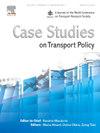Subsidy policy design for high-speed rail express
IF 3.3
Q3 TRANSPORTATION
引用次数: 0
Abstract
The growing demand for high-value cargo transportation and the development of high-speed rail networks have made high speed rail express (HSRE) feasible. Although high-speed rail offers lower carbon emissions, its higher operational costs necessitate government subsidies to balance corporate profitability and social benefits. To address the policy design of subsidies for HSRE, we first employed the Hotelling model to characterize logistics enterprises’ mode choice behavior, thereby determining the demand for both high-speed rail and road. Subsequently, a social welfare maximization model was developed incorporating producer surplus, consumer surplus, government expenditure, and environmental impact, deriving optimal subsidy values under different pricing scenarios. Finally, a case validation analysis was conducted using the HSRE service between Kunming and Chengdu in China. The research reveals that the subsidy value is proportional to the price difference between the two transport modes under fixed-prices scenario—the greater the disparity, the higher the required subsidy. While under equilibrium-prices scenario, the optimal subsidy value depends not only on intermodal cost differentials and carbon pricing but also on cargo time value, transport efficiency, terminal handling capacity, and transfer costs. These findings provide new insights for HSRE subsidy policies design.
高速铁路快运补贴政策设计
高价值货物运输需求的不断增长和高速铁路网的发展使得高速铁路快运(HSRE)成为可能。尽管高铁的碳排放较低,但其较高的运营成本需要政府补贴,以平衡企业盈利能力和社会效益。为了解决高铁补贴的政策设计问题,我们首先采用Hotelling模型来表征物流企业的模式选择行为,从而确定对高铁和公路的需求。在此基础上,建立了考虑生产者剩余、消费者剩余、政府支出和环境影响的社会福利最大化模型,得出了不同价格情景下的最优补贴值。最后,以昆明至成都高铁为例进行了案例验证分析。研究表明,在固定价格情景下,补贴价值与两种运输方式之间的价格差异成正比,差异越大,所需补贴越高。而在均衡价格情景下,最优补贴值不仅取决于多式联运成本差异和碳定价,还取决于货物时间价值、运输效率、终端处理能力和转移成本。这些发现为高铁补贴政策的设计提供了新的见解。
本文章由计算机程序翻译,如有差异,请以英文原文为准。
求助全文
约1分钟内获得全文
求助全文

 求助内容:
求助内容: 应助结果提醒方式:
应助结果提醒方式:


